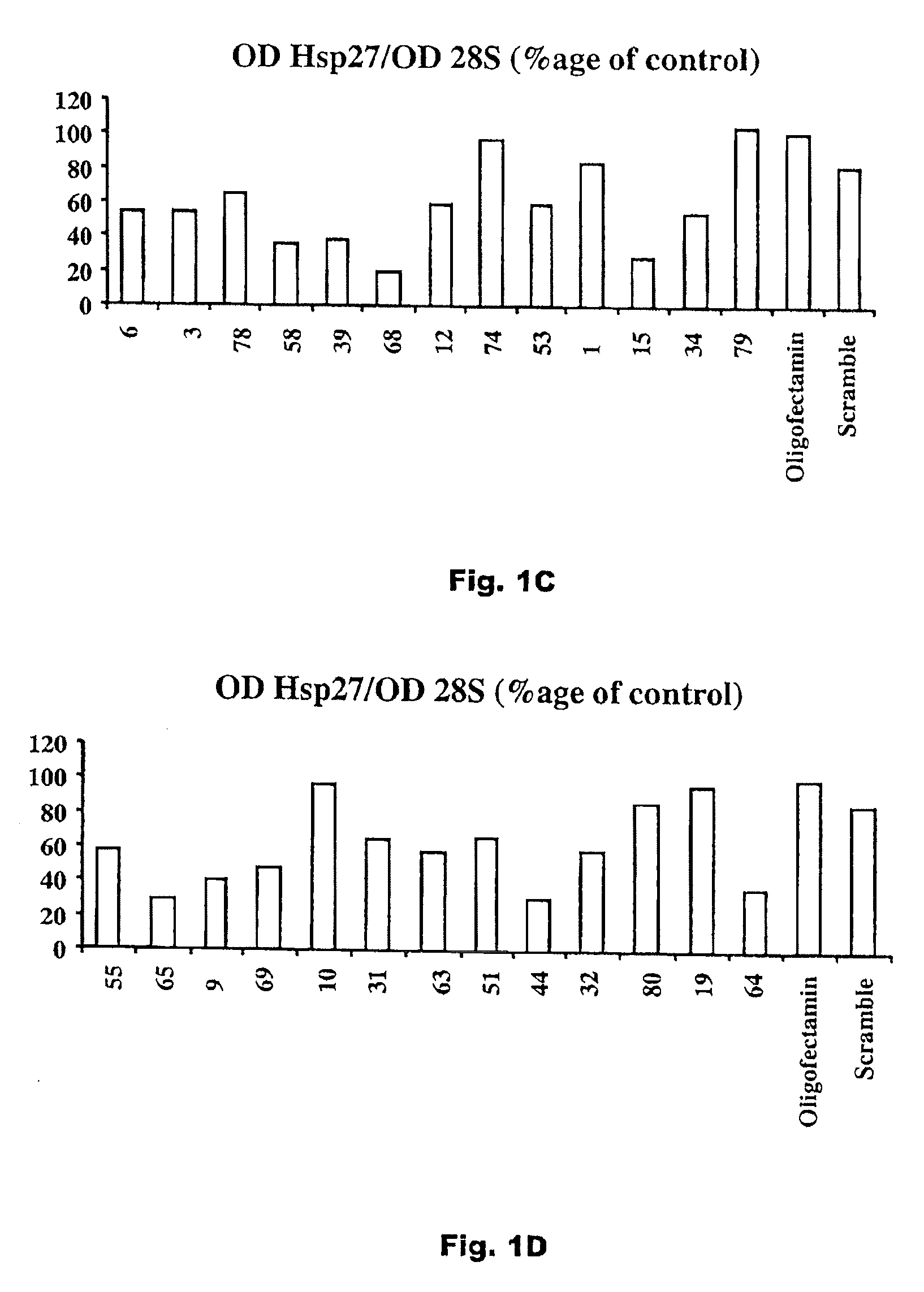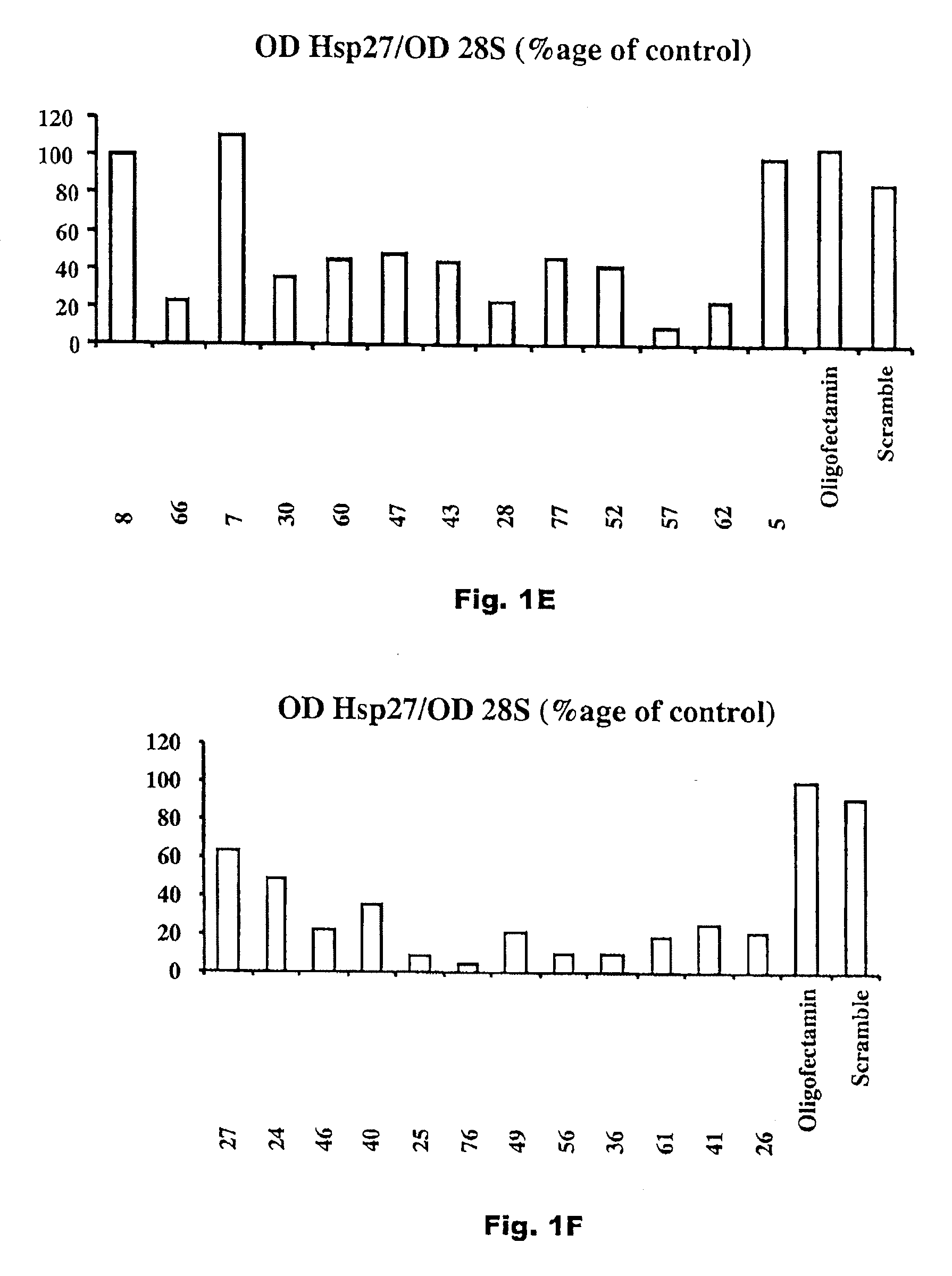Compositions and methods for treatment of prostate and other cancers
a prostate and other cancer technology, applied in the field of prostate and other cancer cancer compositions and methods, can solve the problems of incomplete castration-induced apoptosis, regression of disease, and extensive apoptosis in prostate tumors
- Summary
- Abstract
- Description
- Claims
- Application Information
AI Technical Summary
Benefits of technology
Problems solved by technology
Method used
Image
Examples
example 1
[0033]A plurality of antisense compounds as defined in Seq. ID Nos. 1-81 were prepared, and each sequence was tested for levels of Hsp 27 mRNA expression human prostate cancer PC3 cells by Northern Blot after exposure to 50 nM of a specified antisense oligonucleotide in an Oligofectamine carrier. The results of these tests, as a percentage of an Oligofectamine only control, for Seq. ID Nos. 1-81 are shown in FIGS. 1A-G. As shown, although not all antisense sequences are effective, effective antisense sequences are found throughout the length of the hsp27 mRNA.
example 2
[0034]PC3 prostate cancer cells were transfected at 40% confluency with three concentrations (10, 30 and 50 nM) of 6 different hsp27-antisense oligonucleotides 2 times, successively in 10 cm dishes, using an Oligofectamine carrier. RNA was extracted 48 hours after the first treatment and analyzed by Northern Blot. The antisense oligonucleotides tested were those with Seq. ID Nos. 67, 57, 25, 76, 56 and 36. As controls, a scrambled oligonucleotide and Oligofectamine only experiments were conducted. All of the oligonucleotides tested showed down-regulation of hsp27 with respect to the controls at least at one of the concentrations. Seqs. ID 71 and 74 appeared to be most effective, with significant down-regulation at 10 nM. The results, relative to a GAPDH control are depicted graphically in FIG. 2.
example 3
[0035]Xenografts of LNCaP prostate cancer cells were introduced into mice, and the effect of intraperitoneal injection of hsp27-antisense oligonucleotide (Seq. ID No. 82) administered intraperitoneally, 10 mg / kg., once daily for four weeks following androgen withdrawal by castration was evaluated. As shown in FIGS. 3A and 3B, tumoral volume and serum PSA increased in the weeks following treatment with a scrambled control, indicating progression to androgen independence, and thus, the loss of efficacy of the castration therapy. In contrast, this progression to androgen independence was not observed in the same time period when treatment with the hsp27 antisense oligonucleotide was given.
PUM
| Property | Measurement | Unit |
|---|---|---|
| length | aaaaa | aaaaa |
| stability | aaaaa | aaaaa |
| pharmaceutical composition | aaaaa | aaaaa |
Abstract
Description
Claims
Application Information
 Login to View More
Login to View More - R&D
- Intellectual Property
- Life Sciences
- Materials
- Tech Scout
- Unparalleled Data Quality
- Higher Quality Content
- 60% Fewer Hallucinations
Browse by: Latest US Patents, China's latest patents, Technical Efficacy Thesaurus, Application Domain, Technology Topic, Popular Technical Reports.
© 2025 PatSnap. All rights reserved.Legal|Privacy policy|Modern Slavery Act Transparency Statement|Sitemap|About US| Contact US: help@patsnap.com



